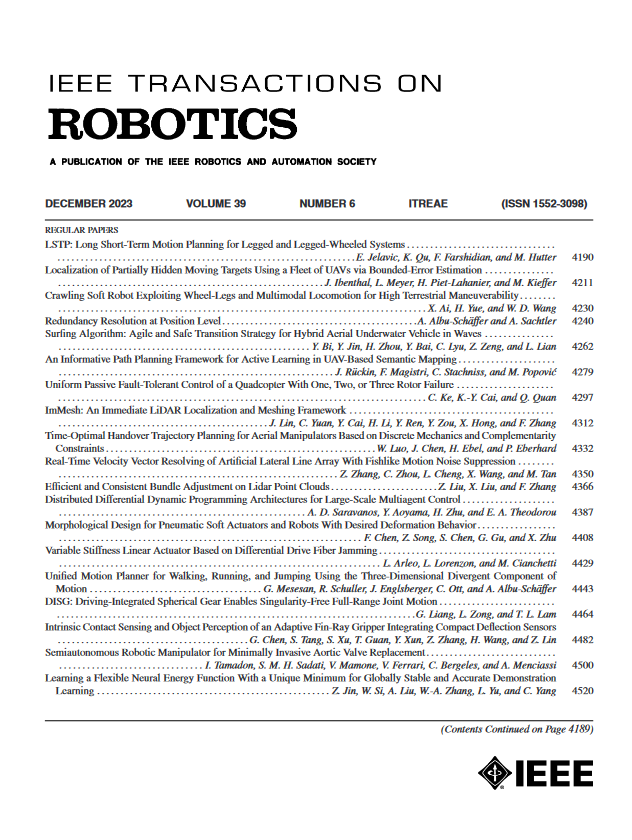Large-Scale Multirobot Coverage Path Planning on Grids With Path Deconfliction
IF 9.4
1区 计算机科学
Q1 ROBOTICS
引用次数: 0
Abstract
In this article, we study multirobot coverage path planning (MCPP) on a four-neighbor 2-D grid基于路径去冲突网格的大规模多机器人覆盖路径规划
在本文中,我们研究了四邻二维网格$G$上的多机器人覆盖路径规划(MCPP),旨在计算多个机器人覆盖$G$的所有单元的路径。传统的方法是有限的,因为它们首先在象限粗化网格$\mathcal {H}$上计算覆盖树,然后使用生成树覆盖(STC)范式在$G$上生成路径,这使得它们不适用于部分阻塞的$2 \乘以2$块的网格。为了解决这一限制,我们直接在$G$上重新制定了问题,彻底改变了基于网格的MCPP求解方法,并建立了新的np硬度结果。我们引入了扩展STC (ESTC),这是一种扩展STC的新范式,即使$\mathcal {H}$包含部分阻塞块,也可以确保STC具有有界次优性的完全覆盖。此外,我们提出了LS-MCPP,这是一个新的算法框架,它将ESTC与三种新型的邻域算子集成在一个局部搜索策略中,以直接在$G$上优化覆盖路径。与先前基于网格的MCPP工作不同,我们的方法还结合了一个多功能后处理程序,该程序首次将多智能体寻径(MAPF)技术应用于MCPP,从而实现了多机器人协调中这两个重要领域的融合。该程序有效地解决了机器人之间的冲突,并通过求解MAPF变体来适应车削成本,使我们的MCPP解决方案在实际应用中更加实用。大量的实验表明,我们的方法显着提高了解决方案的质量和效率,在运行时间的几分钟内,在$\text{256} \乘以\text{256}$的网格上管理多达100个机器人。物理机器人的验证证实了我们的解决方案在现实条件下的可行性。
本文章由计算机程序翻译,如有差异,请以英文原文为准。
求助全文
约1分钟内获得全文
求助全文
来源期刊

IEEE Transactions on Robotics
工程技术-机器人学
CiteScore
14.90
自引率
5.10%
发文量
259
审稿时长
6.0 months
期刊介绍:
The IEEE Transactions on Robotics (T-RO) is dedicated to publishing fundamental papers covering all facets of robotics, drawing on interdisciplinary approaches from computer science, control systems, electrical engineering, mathematics, mechanical engineering, and beyond. From industrial applications to service and personal assistants, surgical operations to space, underwater, and remote exploration, robots and intelligent machines play pivotal roles across various domains, including entertainment, safety, search and rescue, military applications, agriculture, and intelligent vehicles.
Special emphasis is placed on intelligent machines and systems designed for unstructured environments, where a significant portion of the environment remains unknown and beyond direct sensing or control.
 求助内容:
求助内容: 应助结果提醒方式:
应助结果提醒方式:


